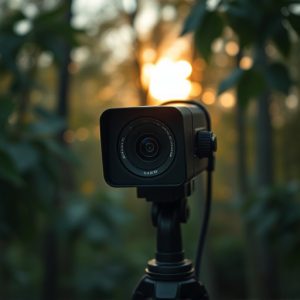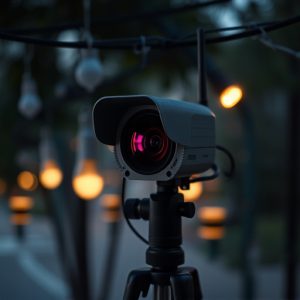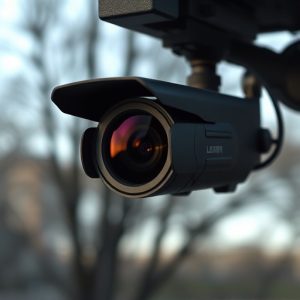Unveiling Hidden Cameras: Advanced Detection with Realistic Decoys
Hidden monitoring devices pose a significant challenge for security professionals. Overcoming this r…….
Hidden monitoring devices pose a significant challenge for security professionals. Overcoming this requires employing Most Realistic Looking Security Decoys that mimic genuine equipment while emitting traceable signals. Strategically placing these decoys in unlikely locations creates a false sense of security, deterring intruders and acting as a powerful psychological deterrent against covert surveillance attempts. By combining these decoys with advanced signal detection equipment, you can create an impenetrable shield against unauthorized surveillance.
Uncover the art of detecting hidden monitoring devices with our comprehensive guide. Learn how sophisticated technology and subtle cues can help identify surveillance equipment, especially advanced hidden cameras. We explore the effectiveness of most realistic looking security decoys as a deterrence strategy, providing insights into visual and behavioral indicators. From understanding signal detection techniques to implementing best practices for a secure environment, this article equips you with essential knowledge to protect your privacy in today’s digital landscape.
- Understanding Hidden Monitoring Device Signal Detection
- The Role of Realistic Security Decoys in Deterring Surveillance
- Visual and Behavioral Cues to Spot Unsuspecting Devices
- Advanced Technology for Identifying Hidden Monitors
- Best Practices for Maintaining a Secure Environment
Understanding Hidden Monitoring Device Signal Detection
Hidden monitoring devices, often disguised as everyday objects, pose a unique challenge for security professionals. The key to detecting these stealthy intrusions lies in understanding their behavior and employing clever tactics. One effective approach is to use the most realistic-looking security decoys available on the market. These decoys mimic genuine devices while emitting signals that can be traced, allowing security teams to identify and neutralize hidden cameras or microphones.
By strategically placing these decoys in areas where monitoring devices are likely to be hidden, such as light fixtures, smoke detectors, or even potted plants, professionals can create a false sense of security for potential intruders. This tactic not only helps in detection but also serves as a powerful deterrent, making it an essential tool in the arsenal against covert surveillance attempts.
The Role of Realistic Security Decoys in Deterring Surveillance
In the ongoing cat-and-mouse game between surveillance detectorists and hidden monitoring device manufacturers, one potent weapon in the defender’s arsenal is the use of realistic security decoys. These are not your ordinary, generic fake cameras or signs; instead, they mimic the appearance and behavior of genuine security equipment, luring would-be intruders away from actual sensors while providing a false sense of security. The most realistic-looking security decoys can be nearly indistinguishable from real hardware, complete with LED indicators that blink like the real thing and motion sensors that trigger like clockwork.
By strategically placing these decoys throughout an area, individuals or organizations can significantly deter potential surveillants. Intruders who are accustomed to spotting obvious security measures may overlook a fake camera, assuming it’s a genuine threat. This tactic not only disrupts surveillance efforts but also serves as a powerful psychological deterrent, making would-be spies think twice before attempting to capture sensitive information.
Visual and Behavioral Cues to Spot Unsuspecting Devices
In the quest to uncover hidden monitoring devices, one often overlooked tactic is paying attention to visual and behavioral cues. While advanced technology can make these gadgets nearly invisible, they still bear telltale signs if you know where to look. Realistic-looking security decoys, for instance, can be a clever way to throw off potential intruders. These mimicry devices are designed to appear as everyday objects—a faux camera or smoke detector—and blend seamlessly into their surroundings, making them the most realistic looking security decoys on the market.
Behavioral patterns can also reveal the presence of hidden monitoring. Unusual movements, like constant adjustments to furniture or frequent glances at specific areas, could indicate a covert listening device or camera. By observing these visual cues and suspicious behaviors, you can become more alert to potential hidden surveillance equipment, enhancing your ability to detect and disable them effectively.
Advanced Technology for Identifying Hidden Monitors
In today’s digital age, technology has advanced significantly in the field of hidden monitoring device detection. One of the most effective ways to identify covert listening devices or cameras is by utilizing innovative security decoys that mimic everyday objects. These sophisticated deceptions are designed to be nearly indistinguishable from regular items, making them excellent tools for professionals who specialize in detecting hidden surveillance equipment. By strategically placing these realistic-looking decoys, such as seemingly ordinary smoke detectors or fire alarms, experts can divert potential eavesdroppers’ attention while conducting a thorough search for any unauthorized monitoring devices.
Additionally, advanced signal detection equipment plays a pivotal role in uncovering hidden monitors. These tools employ cutting-edge algorithms and sensors to analyze electromagnetic radiation, enabling technicians to pinpoint the exact location of transmitting signals. With this technology, even the tiniest radio frequency leaks from covert cameras or microphones can be detected, ensuring that no hidden surveillance goes unnoticed. The combination of highly realistic decoys and advanced detection methods creates an impenetrable shield against unauthorized monitoring, providing peace of mind in a world where privacy is of utmost concern.
Best Practices for Maintaining a Secure Environment
To maintain a secure environment and stay ahead of hidden monitoring device signal detection, implementing best practices with security decoys is paramount. One of the most effective strategies involves employing the most realistic-looking security decoys available. These decoys, designed to mimic genuine security equipment, fool would-be intruders into believing they’re under constant surveillance. By integrating these devices seamlessly into your space, you create a false sense of security for potential threats.
Additionally, regular maintenance and updates of both real and decoy security systems are crucial. Keep all equipment up-to-date with the latest technology to ensure maximum effectiveness. Regularly test and rotate the locations of security decoys to maintain their unpredictability. This continuous adaptation makes it harder for anyone to anticipate your defense mechanisms, enhancing your overall security posture.
In conclusion, the detection of hidden monitoring devices requires a multi-faceted approach. By understanding the latest technologies, employing advanced signal detection methods, and utilizing realistic security decoys, individuals can significantly deter surveillance attempts. Incorporating visual and behavioral cues, along with best practices for maintaining a secure environment, ensures a comprehensive strategy to protect privacy and personal safety in today’s digital age. Remember that staying one step ahead of potential surveillants is key, and the most realistic-looking security decoys play a pivotal role in this endeavor.


